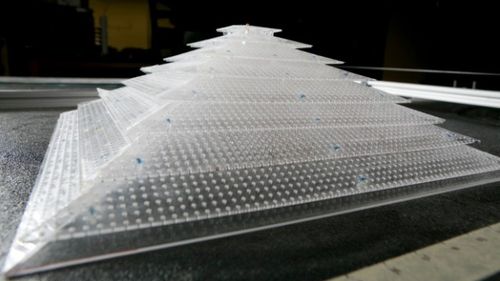Steven Cummer, a professor of electrical and computer engineering at Duke University and his lab has just revealed a three-dimensional pyramid-shaped device that can cloak an object from acoustic detection. The cloak has been described in a new paper published in Nature Materials.
When sound waves hit an object, they bounce off and return to the point of origin. The time it takes the sound to be emitted and then bounce back can provide information about the object’s distance. Active acoustic location is used in the animal kingdom as echolocation and those same principles have been used to develop sonar for human use. (This is in contrast to passive acoustic location, which detects sound waves created by something else in order to determine the object's location.)
The cloak is known as a metamaterial, as it combines natural materials (air) with manmade materials (plastic) to create unnatural results. Therein lies the beauty of the device: there are no computer chips or electronic sensors, it is just plastic and air. This will surely help keep costs down when it comes to manufacturing more of the cloaks later.
Though the construction of the cloak looks fairly simple, countless calculations and measurements went into its meticulous construction. The plastic sheeting and holes are all very strategically arranged. When sound waves hit the device, they are very carefully guided through the cloak and do not hit the object that is being concealed. From the perspective of the acoustic location device, there is nothing but flat surface as the object and the pyramid appear invisible. The shape of the cloak allows for sound to pass through equally, no matter where the sound originated.
The device was put to the test by attempting to cloak a small sphere. An acoustic locator “pinged” the cloak from several directions and the team mapped the trajectory of the sound waves. Aside from very minor distortions, it essentially appeared as though there was nothing but a flat table there.
Currently, the cloak has only been tested in the air, though they predict it would work similarly under water. This could have large implications for Naval applications, as they might be able to hide objects from sonar signals. Even outside of the military, there is practical use for Cummer’s design. A building’s structural needs do not always align with the acoustic needs of a theater or auditorium, as load-bearing beams can bounce sound around in an undesirable way. By cloaking the beam, the sound could be re-routed and the acoustics of the room would not need be compromised.
)



